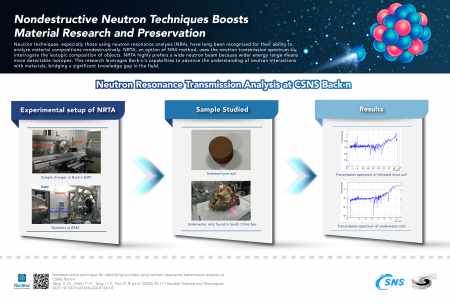博文
[转载]无损中子技术促进材料研究与保护的发展
||
Article title: Nondestructive technique for identifying nuclides using neutron resonance transmission analysis at CSNS Back-n
文章标题:在CSNS Back-n利用中子共振透射分析实现核素无损识别的技术
DOI: 10.1007/s41365-024-01367-8
一句话概要:
This study showcases a remarkable nondestructive technique using Neutron Resonance Transmission Analysis at CSNS Back-n, fulfilling the identification of various nuclides in materials ranging from imitated lunar soil to underwater relics.
本研究展示了在CSNS Back-n应用中子共振透射分析开展的一种无损检测技术,实现了对模拟月球土壤和海底文物中多种核素的识别。
关键词:
CSNS, white neutron beam, NRTA, nuclide identification, nondestructive method
CSNS、白光中子束流、NRTA、核素识别、无损检测方法

The Novelty (What)
创新性(主要内容)
This research introduces the test experiments for the feasibility study, showcasing the effective use of Neutron Resonance Transmission Analysis (NRTA) at the CSNS Back-n facility. The study's major achievement lies in its confirmation that NRTA can accurately identify a range of nuclides, including 16O, 28Si, 27Al, 54Fe, 56Fe, 24Mg, and 23Na in a simulated lunar soil sample, and 63Cu, 65Cu, 16O, 28Si, 56Fe, 40Ca, and 23Na in an underwater relic. This approach leverages the broad energy spectrum of neutrons (from eV to 300 MeV) available at Back-n, a notable advancement in nondestructive material analysis. The success of this study not only establishes the effectiveness of the NRTA method in identifying these specific isotopes with high precision but also sets the stage for future research and applications in diverse fields, potentially improving the way materials are analyzed.
本项研究通过测试实验,表明了在CSNS Back-n装置应用中子共振透射分析(NRTA)技术的可行性和有效性。研究成果表明NRTA技术能够准确识别多种核素,包括模拟月球土壤样本中的16O、28Si、27Al、54Fe、56Fe、24Mg、23Na,以及在海底文物中的63Cu、65Cu、16O、28Si、56Fe、40Ca、23Na等。这种方法充分利用了Back-n宽中子能谱的优势(从电子伏到300兆电子伏),是无损检测分析方面的显著进步。该项研究的成功不仅证明了NRTA方法在高精度识别这些特定同位素方面的有效性,也为未来在多个领域内的研究和应用奠定了基础,有望改进材料分析的方式。
The Background (Why)
研究背景(主要原因)
Neutron techniques, especially those using neutron resonance analysis (NRA), have long been recognized for their ability to analyze material compositions nondestructively. NRTA, an option of NRA method, uses the neutron transmission spectrum to interrogate the isotopic composition of objects. NRTA highly prefers a wide neutron beam because wider energy range means more detectable isotopes. The introduction of the NRTA method at the Back-n facility gives full play to its wide energy spectrum, from eV to 300 MeV. The study's thesis revolves around harnessing the unique properties of Back-n to enhance the NRTA method, thereby offering a more comprehensive and non-invasive approach to material analysis.
中子技术,尤其是基于中子共振分析(NRA)的技术,长期以来因其具有无损检测材料成分的能力而受到认可。NRTA是一种通过中子透射率谱来检测物体元素成分的NRA方法。NRTA特别适合于宽中子能谱束流,因为更宽的能量范围意味着能检测到更多的同位素。在Back-n装置开展NRTA方法研究能够充分发挥其宽能谱(从电子伏到300兆电子伏)的优势。这项研究主要围绕着利用Back-n的独特属性来增强NRTA方法,从而提供一种更全面、非侵入式的材料分析方法。
The SDG impact (Big Why)
SDG影响力(研究意义)
The urgency to develop technologies that support sustainable practices while preserving cultural and historical artifacts has never been more pronounced. The successful implementation of Neutron Resonance Transmission Analysis (NRTA), a nondestructive technique, at China Spallation Neutron Source’s Back-n facility is meaningful to scientific research across multiple disciplines. This advancement comes at a critical time when the global emphasis on sustainable industrial processes and cultural heritage preservation is at an all-time high. This research directly contributes to the United Nations Sustainable Development Goal 9 (Industry, Innovation, and Infrastructure) by promoting innovative technological development in industrial processes. Additionally, the study significantly aligns with SDG 11 (Sustainable Cities and Communities), particularly in its implications for cultural heritage preservation.
当前,开发既支持可持续实践又能保护文化和历史遗产的技术的紧迫性前所未有地凸显出来。在中国散裂中子源的Back-n装置成功实施的中子共振透射分析(NRTA)无损检测技术对跨学科研究具有重要意义。这一进展正值全球对可持续工业流程和文化遗产保护重视程度空前高涨的关键时刻。该研究通过创新技术发展直接促进了联合国可持续发展目标9(产业、创新和基础设施)的实现。此外,该研究与可持续发展目标11(可持续城市和社区)高度一致,特别是在文化遗产保护的意义上。
https://wap.sciencenet.cn/blog-3474219-1433089.html
上一篇:[转载]机器学习对预测超重元素衰变的影响
下一篇:[转载]快速核测量促进清洁能源